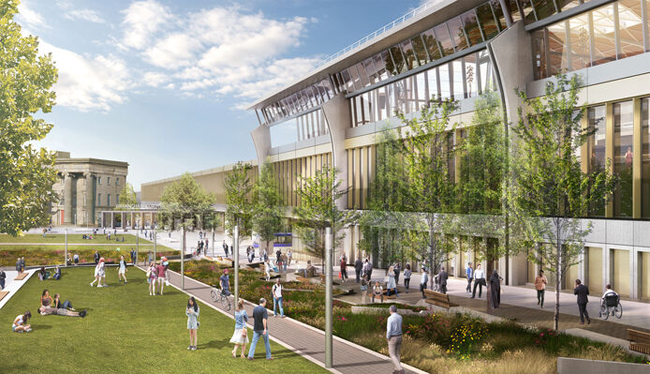HS2 Ltd has started a major project to restore the Grade 1 listed Old Curzon Street Station in Birmingham, one of the world's oldest surviving pieces of monumental railway architecture.
The building has been integrated into plans for the new Curzon Street Station, which provide 'an enhanced setting to reflect the history of the old station' as well as the Grade II listed Woodman pub.
The public space surrounding the station will feature the historic track alignments of the former goods yard that used to lie to its east, and the gardens and new eastern concourse façade have also been designed to complement the architecture of the building.
Over the next twelve months, a team of local experts will carry out intricate restoration work on the building, which opened in 1838 as the Birmingham terminus for the London and Birmingham Railway Co. (L&BR) line that connected to Euston Station in London.
The project will be undertaken by KN Circet Transport and Infrastructure division, who are working for HS2’s enabling works contractor LMJV (Laing O’Rourke and J. Murphy & Sons).
Work will include a new steel structural frame to strengthen the building, a new lift giving access to all four levels, new glass balustrade for the historic staircase, internal fit-out, roof repairs, structural repairs to the external façade, and a full clean of the external building masonry.
Russell Bailey, HS2 project manager for Old Curzon Street Station said: ‘The revamped building is integrated into HS2’s plans for the city’s landmark Curzon Street Station, which will be the first brand new intercity terminus station built in Britain since the 19th century. Work is set to start on building the new station in the next year, with the joint venture contractor Mace Dragodos set to create 1,000 jobs.’

The old station building will remain next to the new station
Mike Neary, project manager for LMJV said: ‘This is a fantastic and truly unique opportunity for our teams to work on such an iconic building from Birmingham’s past, and it will be a privilege to bring this important building back to life. The exciting part of their job is exposing the different structures so they can assess how to restore them using the same traditional methods, such as how the floor joists have been put together.’
The station was the first railway terminus serving the centre of Birmingham and suffered extensive damage during the Birmingham Blitz, before surviving two applications for its demolition in the 1970s. It is now listed on Historic England’s Heritage at Risk Register.
The refurbishment will see this status change for the first time in over a decade, with future plans to use it as an HS2 visitors centre, with flexible facilities for office space, exhibition purposes and catering.
Register now for full access
Register just once to get unrestricted, real-time coverage of the issues and challenges facing UK transport and highways engineers.
Full website content includes the latest news, exclusive commentary from leading industry figures and detailed topical analysis of the highways, transportation, environment and place-shaping sectors.
Use the link below to register your details for full, free access.
Already a registered? Login